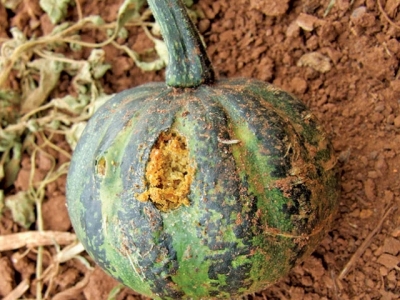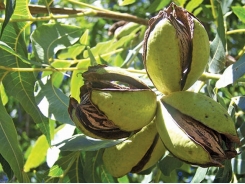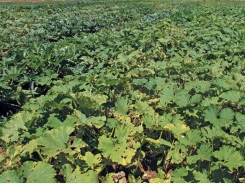Strategies for pumpkin fly control

Pumpkin fly is a pest every cucurbit grower will know. It is similar to a fruit fly but, as its name suggests, it parasitises members of the pumpkin family.
This squash was stung at a more advanced stage. Photo: Bill Kerr
It inserts its ovipositor into the developing fruit and lays a cluster of eggs. When these hatch, the young maggots start eating the flesh, destroying the fruit, causing it to be aborted, or making a hollow, which renders the fruit unmarketable. When the maggots mature, they leave the fruit and fall to the ground.
Here, they bring head and posterior together, then release, ‘springing’ to a new site, where they pupate in the soil.
The maggots start off white and become yellow at maturity. The life cycle can last as little as three weeks under favourable conditions. The initial ‘sting’ in the fruit leaves a puncture mark surrounded by a sunken area.
In baby marrows, this makes the fruit unsightly. The degree of damage to pumpkins and butternuts depends on the fruit’s stage of development. If the fly ‘stings’ butternuts and pumpkins at a fairly advanced stage, it may simply make a lesion that degrades the fruit, but still leaves it marketable.
By contrast, when young fruit are attacked, they usually turn yellow and stop growing. In cold areas, the pest may only strike later in the season as severe cold tends to break its life cycle. This past summer was the first one I can remember that has been free of pumpkin flies. However, the pest did eventually start arriving at growers a few kilometres away from my farm.
Early hatchlings
It’s possible to stop the pumpkin fly problem in its tracks by killing off the early hatchlings that made it through winter. And if you bait the crop just before flowering as well as during early flowering, you could slow down the pest dramatically. With crops such as baby marrows, be careful to destroy, not discard, stung fruit in the packhouse.
With baby marrows, female flowers often open before male flowers. This fruit will not develop and is often just left on the plant. Here it is a frequent source of an early fly build-up. For this reason, this fruit should be harvested with the first fruits and destroyed at the packhouse. This may save a lot of money and effort later.
Pesticides
Various effective chemical options to control this pest are available. Application can be by means of a knapsack sprayer with a ‘hole in a disc’ type of nozzle and the whorl plate removed. This emits a stream of the mixture, rather than a fine spray. The flies need to feed on large droplets on the foliage.
The bait is made up of 150g Mercaptothion with 4kg of sugar in 20l of water. (A protein attractant can be used in place of sugar.)
Plan on using 40l/ha. Ideally, you should aim to get the droplets underneath the leaves. The angle makes this awkward; the best way to solve the problem is to fit an elbow onto the nozzle so that the operator can move down the rows squirting the bait onto the underside of the leaves.
An alternative method is to randomly squirt alternate sides reaching about 10m into the crop. This can be effective, as well as quicker and cheaper.
Systemic products such as Fenthion can even kill the flies that sting the fruit soon after application, as well as eggs and maggots for a few days after application. The fruit needs to be wetted as well.
This product will also help to reduce the aphid population. Remember, though, that it has a withholding period, which limits its use on baby marrows as this fruit is harvested almost daily.
Pyrethroids can also be used to kill the flies landing on the leaves. Be warned, though: these products may kill off the parasitoids that control leaf miner and thereby cause an outbreak of this pest. The most important consideration, regardless, is to get rid of the flies in time. Doing this will save you significant costs later on.
Có thể bạn quan tâm
Phần mềm

Phối trộn thức ăn chăn nuôi

Pha dung dịch thủy canh

Định mức cho tôm ăn

Phối trộn phân bón NPK

Xác định tỷ lệ tôm sống

Chuyển đổi đơn vị phân bón

Xác định công suất sục khí

Chuyển đổi đơn vị tôm

Tính diện tích nhà kính

Tính thể tích ao hồ




 Guidelines on buying good-quality nursery trees
Guidelines on buying good-quality nursery trees  Why pumpkins need space to grow
Why pumpkins need space to grow